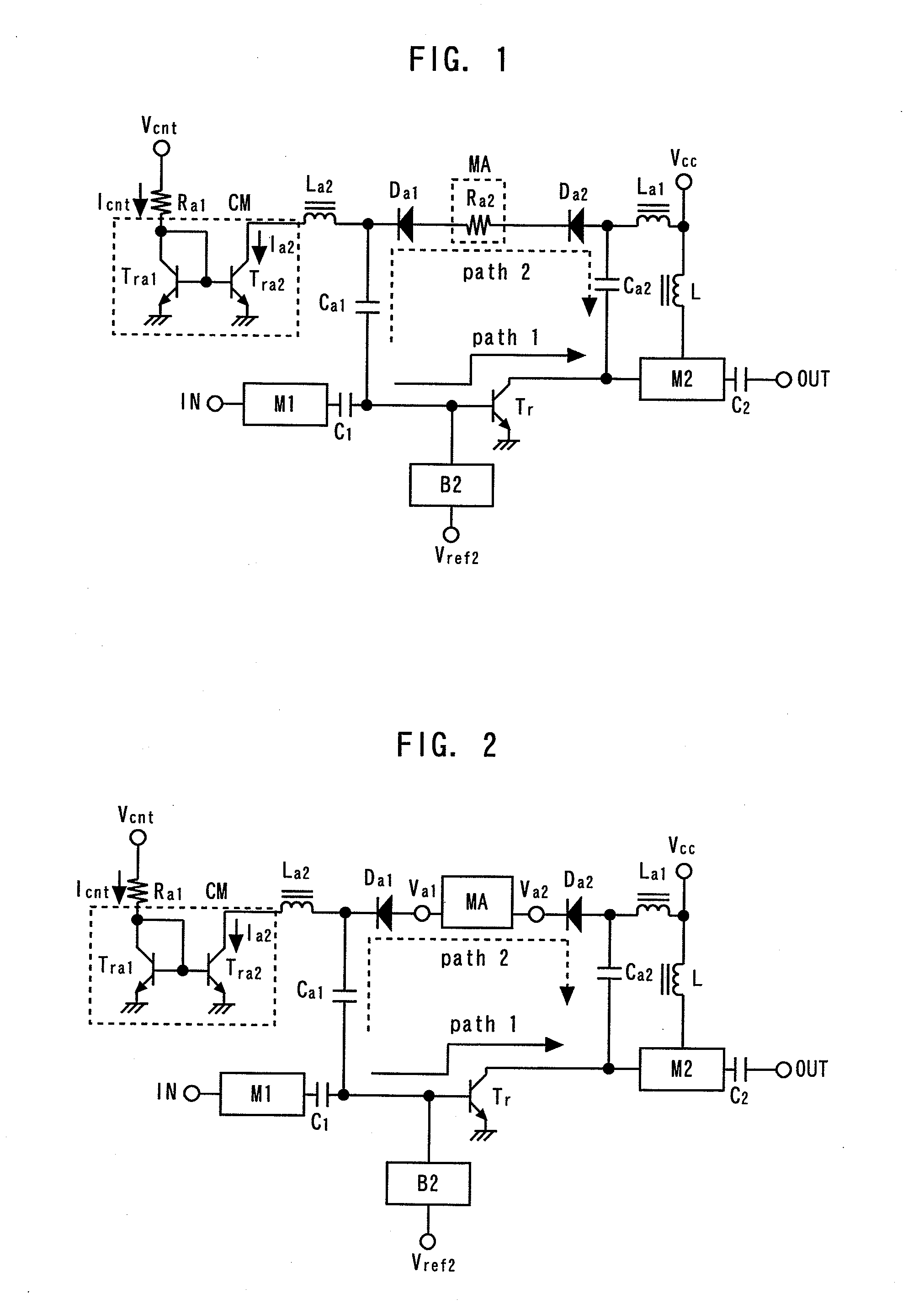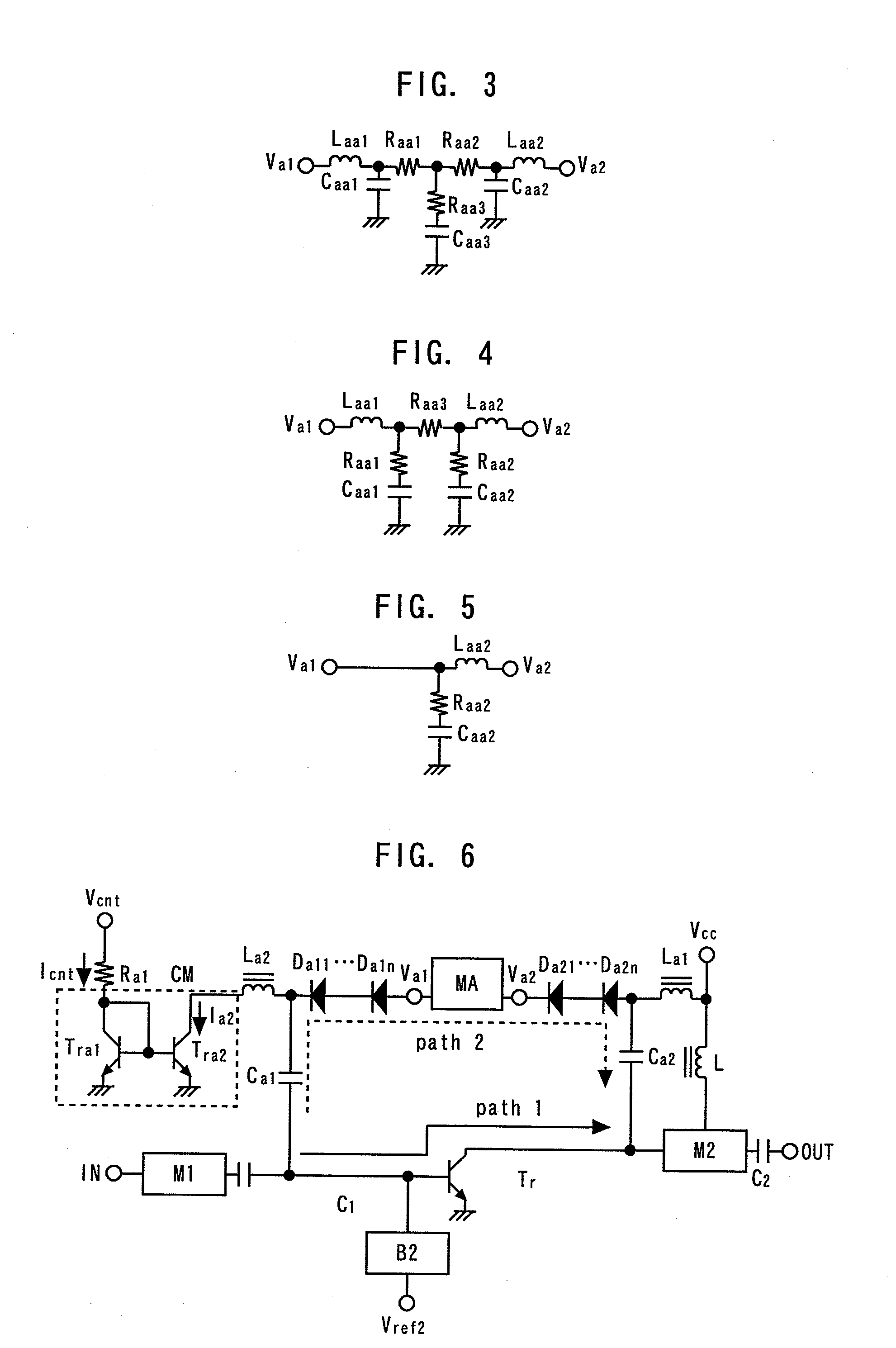Power amplifier
a power amplifier and amplifier technology, applied in the direction of amplifiers with semiconductor devices only, amplifiers with semiconductor devices, amplifiers with control details, etc., can solve the problems of large impedance mismatches, inability to perform design of power amplifiers and bypass circuits independently of each other, and difficulty in matching impedance in amplification mode and attenuation mode, so as to reduce the minimum operating voltage, reduce input and output impedance mismatches, and increase the degree of design freedom
- Summary
- Abstract
- Description
- Claims
- Application Information
AI Technical Summary
Benefits of technology
Problems solved by technology
Method used
Image
Examples
first embodiment
[0052]FIG. 1 is a circuit diagram showing a power amplifier according to a first embodiment of the present invention. This power amplifier is formed by a GaAs-HBT process.
[0053]An amplifying transistor Tr which amplifies an RF signal has its base connected to an input terminal IN via an input matching circuit M1 and a capacitor C1 (first capacitor), has its collector connected to an output terminal OUT via an output matching circuit M2 and a capacitor C2 and has its emitter grounded. An inductor L is provided between a collector power supply terminal Vcc and the output matching circuit M2. A bias circuit B2 supplies a bias current to the base of the amplifying transistor Tr according to a voltage applied to a control terminal Vref.
[0054]The cathode of a BC diode Da1 (first diode) is connected to the input terminal IN via a capacitor Ca1 (second capacitor), the capacitor C1 and the input matching circuit M1. The anode of a BC diode Da2 (second diode) is connected to the output termin...
second embodiment
[0062]FIG. 2 is a circuit diagram showing a power amplifier according to a second embodiment of the present invention. The second embodiment differs from the first embodiment in the configuration of the matching and attenuating circuit MA. The circuit configuration of the matching and attenuating circuit according to the second embodiment will be described. It is assumed here that the matching and attenuating circuit MA has a terminal Va1 connected to the anode of the BC diode Da1 and a terminal Va2 connected to the cathode of the BC diode Da2.
[0063]FIG. 3 is a circuit diagram showing a first example of the matching and attenuating circuit according to the second embodiment. An inductor Laa1, a resistor Raa1, a resistor Raa2 and an inductor Laa2 are connected in series between the terminal Va1 and the terminal Va2. A capacitor Caa1 is connected between an inductor Laa1-resistor Raa1 connection point and a grounding point. A resistor Raa3 and a capacitor Caa3 are connected in series ...
third embodiment
[0067]FIG. 6 is a circuit diagram showing a power amplifier according to a third embodiment of the present invention. The third embodiment differs from the second embodiment in that each of the first and second diodes comprises a plurality of diodes connected in series. That is, a plurality of BC diodes Da11 to Da1n are connected in series as the first diode in place of the BC diode Da1, and a plurality of BC diodes Da21 to Da2n are connected in series as the second diode in place of the BC diode Da2. In this way, insufficiency of isolation of the path 2 in the amplification mode can be remedied. Other effects, which are the same as those of the second embodiment, can also be obtained.
PUM
 Login to View More
Login to View More Abstract
Description
Claims
Application Information
 Login to View More
Login to View More - R&D
- Intellectual Property
- Life Sciences
- Materials
- Tech Scout
- Unparalleled Data Quality
- Higher Quality Content
- 60% Fewer Hallucinations
Browse by: Latest US Patents, China's latest patents, Technical Efficacy Thesaurus, Application Domain, Technology Topic, Popular Technical Reports.
© 2025 PatSnap. All rights reserved.Legal|Privacy policy|Modern Slavery Act Transparency Statement|Sitemap|About US| Contact US: help@patsnap.com



